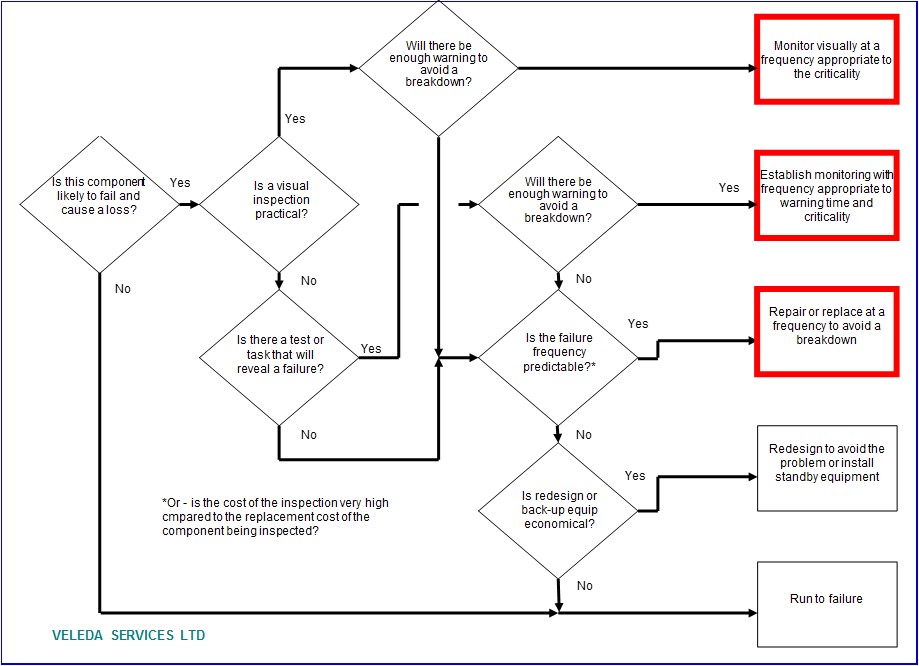Here are a few ideas on setting up a preventive maintenance (PM) programme that will support your reliability objectives without costing more than it needs to. The comments below apply to both condition monitoring and routine servicing (see “Preventive Maintenance – two kinds“).
- Make sure that the components of the equipment you are inspecting have failure modes that make “condition monitoring” inspections worth while.
If they are likely to fail quickly (fuses and shear pins come to mind), inspections are of no value. In the decision tree below, equipment and components which lend themselves to preventive maintenance are in the red boxes.

- Set condition monitoring inspection frequencies so that almost all probable failures will be detected in time to make the required repairs during scheduled shutdowns, and before a breakdown occurs.
The time between inspections should be less than one half of the “failure development time”, which is the elapsed time from when a failure first starts to make itself apparent until the component ceases to function.
Failure development times depend on the type of component and its “operating context” (load, speed, etc). For some equipment this information may be available from the manufacturer, for others it comes from experience. Predictive maintenance techniques, such as vibration and oil analyses, extend the failure development period by detecting failures earlier and by monitoring the rate of deterioration prior to breakdown.
- Make sure that your equipment is in good condition before you start routine PM inspections and servicing.
As an example, consider a plain bearing, grease lubricated. If the running clearance is within the manufacturer’s tolerances then lubricating at the recommended frequency will keep it in good operating condition. However, if the bearing has been neglected and has worn significantly, the resulting metal-to-metal contact will cause accelerated wear to continue, even with regular lubrication.
- Set up inspection routes that make it easy for the inspectors. For example
– match the estimated time to complete a route to normal work breaks. Four 2-hour inspection routes are normally easier for the inspector to manage than one 8-hour route.
– minimize the administrative effort. Hand-held instruments may assist by advising the inspector if there is an existing work order for a “found” failure, providing equipment history in the field and recording failures.
– provide all the information that’s needed, e.g. the location of the equipment and its isolating devices if equipment needs to be locked out to inspect or service.
– design the inspection/servicing route to minimize the travel required, including climbing stairs, etc
- Assign the right people to PM routines.
Skilled tradespeople do not always make the best inspectors. Most inspections do not require a high level of trades skill, and selecting people who have a natural interest in routine work and in taking responsibility for an area will provide better results.
- Manage the PM programme.
This is essential. PM scope and frequency should be under continuous review to ensure that the amount of PM work being done is minimized without jeopardizing reliability. This is a skilled balancing act requiring disciplined technical leadership.
Whenever a breakdown occurs, the PM specialist should decide if a PM programme change is needed to prevent it happening again.
To return to the Articles index click here.
© Veleda Services Ltd
Don Armstrong, P.Eng, President
don.armstrong@veleda.ca
250-655-8267 Pacific Time
Canada
